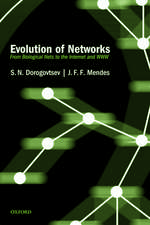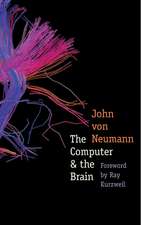Chaos: Concepts, Control and Constructive Use: Understanding Complex Systems
Autor Yurii Bolotin, Anatoli Tur, Vladimir Yanovskyen Limba Engleză Paperback – 14 mar 2012
| Toate formatele și edițiile | Preț | Express |
|---|---|---|
| Paperback (2) | 388.13 lei 6-8 săpt. | |
| Springer International Publishing – 28 iun 2018 | 388.13 lei 6-8 săpt. | |
| Springer Berlin, Heidelberg – 14 mar 2012 | 686.97 lei 6-8 săpt. | |
| Hardback (1) | 395.47 lei 6-8 săpt. | |
| Springer International Publishing – noi 2016 | 395.47 lei 6-8 săpt. |
Din seria Understanding Complex Systems
- 18%
 Preț: 1112.30 lei
Preț: 1112.30 lei -
 Preț: 439.25 lei
Preț: 439.25 lei - 18%
 Preț: 1119.38 lei
Preț: 1119.38 lei - 15%
 Preț: 401.82 lei
Preț: 401.82 lei - 18%
 Preț: 1247.26 lei
Preț: 1247.26 lei - 15%
 Preț: 641.20 lei
Preț: 641.20 lei - 15%
 Preț: 642.68 lei
Preț: 642.68 lei - 15%
 Preț: 651.51 lei
Preț: 651.51 lei - 18%
 Preț: 946.55 lei
Preț: 946.55 lei - 18%
 Preț: 947.98 lei
Preț: 947.98 lei - 20%
 Preț: 650.27 lei
Preț: 650.27 lei - 18%
 Preț: 952.09 lei
Preț: 952.09 lei - 18%
 Preț: 957.13 lei
Preț: 957.13 lei - 18%
 Preț: 943.88 lei
Preț: 943.88 lei -
 Preț: 398.35 lei
Preț: 398.35 lei - 5%
 Preț: 1417.54 lei
Preț: 1417.54 lei - 15%
 Preț: 648.42 lei
Preț: 648.42 lei -
 Preț: 387.75 lei
Preț: 387.75 lei - 18%
 Preț: 1133.76 lei
Preț: 1133.76 lei - 18%
 Preț: 948.16 lei
Preț: 948.16 lei - 20%
 Preț: 655.85 lei
Preț: 655.85 lei - 18%
 Preț: 1113.09 lei
Preț: 1113.09 lei - 20%
 Preț: 655.53 lei
Preț: 655.53 lei - 15%
 Preț: 653.00 lei
Preț: 653.00 lei - 18%
 Preț: 1392.77 lei
Preț: 1392.77 lei - 18%
 Preț: 1010.48 lei
Preț: 1010.48 lei - 18%
 Preț: 955.56 lei
Preț: 955.56 lei -
 Preț: 384.22 lei
Preț: 384.22 lei - 18%
 Preț: 950.66 lei
Preț: 950.66 lei - 15%
 Preț: 638.43 lei
Preț: 638.43 lei - 15%
 Preț: 644.49 lei
Preț: 644.49 lei - 15%
 Preț: 647.40 lei
Preț: 647.40 lei - 15%
 Preț: 649.06 lei
Preț: 649.06 lei - 15%
 Preț: 639.25 lei
Preț: 639.25 lei - 15%
 Preț: 643.65 lei
Preț: 643.65 lei - 18%
 Preț: 960.78 lei
Preț: 960.78 lei - 15%
 Preț: 649.87 lei
Preț: 649.87 lei - 15%
 Preț: 645.47 lei
Preț: 645.47 lei
Preț: 686.97 lei
Preț vechi: 808.21 lei
-15% Nou
Puncte Express: 1030
Preț estimativ în valută:
131.46€ • 136.42$ • 109.88£
131.46€ • 136.42$ • 109.88£
Carte tipărită la comandă
Livrare economică 17-31 martie
Preluare comenzi: 021 569.72.76
Specificații
ISBN-13: 9783642269226
ISBN-10: 3642269222
Pagini: 208
Ilustrații: VIII, 198 p. 90 illus.
Dimensiuni: 155 x 235 x 11 mm
Greutate: 0.3 kg
Ediția:2009
Editura: Springer Berlin, Heidelberg
Colecția Springer
Seria Understanding Complex Systems
Locul publicării:Berlin, Heidelberg, Germany
ISBN-10: 3642269222
Pagini: 208
Ilustrații: VIII, 198 p. 90 illus.
Dimensiuni: 155 x 235 x 11 mm
Greutate: 0.3 kg
Ediția:2009
Editura: Springer Berlin, Heidelberg
Colecția Springer
Seria Understanding Complex Systems
Locul publicării:Berlin, Heidelberg, Germany
Public țintă
ResearchCuprins
Paradigm for Chaos.- Main Features of Chaotic Systems.- Reconstruction of Dynamical Systems.- Controlling Chaos.- Synchronization of Chaotic Systems.- Stochastic Resonance.- The Appearance of Regular Fluxes Without Gradients.
Recenzii
From the reviews:
“This book is an excellent introduction to the key concepts and control of chaos in (random) dynamical systems in order to reach a large audience from science and engineering. The presentation is organized in 8 chapters. … The authors find an outstanding balance between main physical ideas and mathematical terminology to reach their audience in an impressive and lucid manner. This book is ideal for anybody who likes to grasp quickly the main issues related to chaos in discrete and continuous time.” (Henri Schurz, Zentralblatt MATH, Vol. 1178, 2010)
“This book is an excellent introduction to the key concepts and control of chaos in (random) dynamical systems in order to reach a large audience from science and engineering. The presentation is organized in 8 chapters. … The authors find an outstanding balance between main physical ideas and mathematical terminology to reach their audience in an impressive and lucid manner. This book is ideal for anybody who likes to grasp quickly the main issues related to chaos in discrete and continuous time.” (Henri Schurz, Zentralblatt MATH, Vol. 1178, 2010)
Textul de pe ultima copertă
The study of chaotic behaviour in nonlinear, dynamical systems is now a well established research domain with ramifications into all fields of sciences, spanning a vast range of applications, from celestial mechanics, via climate change, to the functioning of brownian motors in cells.
A more recent discovery is that chaos can be controlled and, under appropriate conditions, can actually be constructive in the sense of becoming a control parameter itself for the system under investigation, stochastic resonance being a prime example.
The present work is putting emphasis on the latter aspects, and after recalling the paradigm changes introduced by the concept of chaos, leads the reader skillfully through the basics of chaos control by detailing relevant algorithms for both Hamiltonian and dissipative systems amongst others.
The main part of the book is then devoted to the issue of synchronization in chaotic systems, an introduction to stochastic resonance and a survey of ratchet models.
This short and concise primer is particularly suitable for postgraduate students and non-specialist scientists from related areas, wishing to enter the field quickly and efficiently.
A more recent discovery is that chaos can be controlled and, under appropriate conditions, can actually be constructive in the sense of becoming a control parameter itself for the system under investigation, stochastic resonance being a prime example.
The present work is putting emphasis on the latter aspects, and after recalling the paradigm changes introduced by the concept of chaos, leads the reader skillfully through the basics of chaos control by detailing relevant algorithms for both Hamiltonian and dissipative systems amongst others.
The main part of the book is then devoted to the issue of synchronization in chaotic systems, an introduction to stochastic resonance and a survey of ratchet models.
This short and concise primer is particularly suitable for postgraduate students and non-specialist scientists from related areas, wishing to enter the field quickly and efficiently.
Caracteristici
Offers a concise introduction to the key concepts and control of chaos in dynamical systems Explores, in this second edition, the many interfaces of quantum physics and dynamical systems Examines the potential role of chaos as control parameter itself in applications














